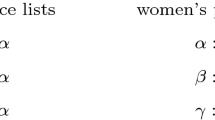Abstract
The stable marriage problem (SMP) is a combinatorial problem to find stable matching between n women and n men given a complete preference list of men over women and vice versa. An instance of the SMP can be expressed by a bipartite graph with multiple (weighted) edges. By rearranging the graph, we use a diagram that involves several constraints to visualize several symmetries. By the diagram, all instances of the size-three SMP (three women and three men) are classified. The classification may be supported by the fact that the same class has the same stable matching.
Similar content being viewed by others
Explore related subjects
Discover the latest articles and news from researchers in related subjects, suggested using machine learning.References
Gale D, Shapley LS (1962) College admissions and the stability of marriage Am Math Monthly 69:9–15
Gusfield D, Irving RW (1989) The stable marriage problem: structure and algorithm. MIT Press, London
Morizumi Y, Hayashi T, Ishida Y (2009) A network visualization of stable matching in the stable marriage problem. Proceedings of AROB
Balinski M, Ratier G (1997) Of stable marriages and graphs, and strategy and polytopes. SIAM Rev 39:575–604
Nemoto T (2002) Handbook of applied mathematical programming (in Japanese). Asakura Syoten, pp 779–830
Veklerov E (1989) On the decomposability of the stable marriage problem. BIT Numerical Math 29(1):41–46
Author information
Authors and Affiliations
Corresponding author
About this article
Cite this article
Hayashi, T., Hata, Y. & Ishida, Y. A diagrammatic classification in a combinatorial problem: the case of the stable marriage problem. Artif Life Robotics 16, 575–579 (2012). https://doi.org/10.1007/s10015-011-0993-x
Received:
Accepted:
Published:
Issue Date:
DOI: https://doi.org/10.1007/s10015-011-0993-x




